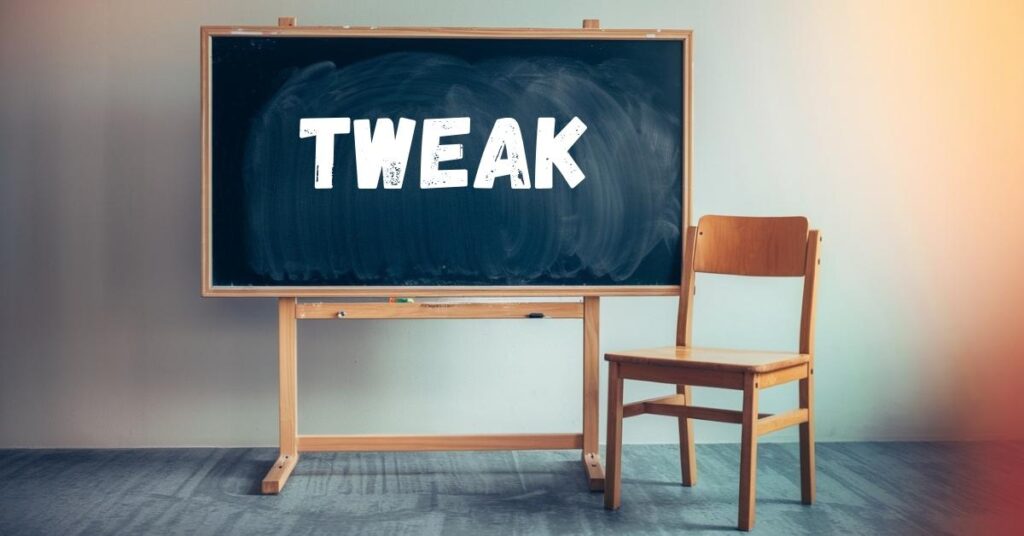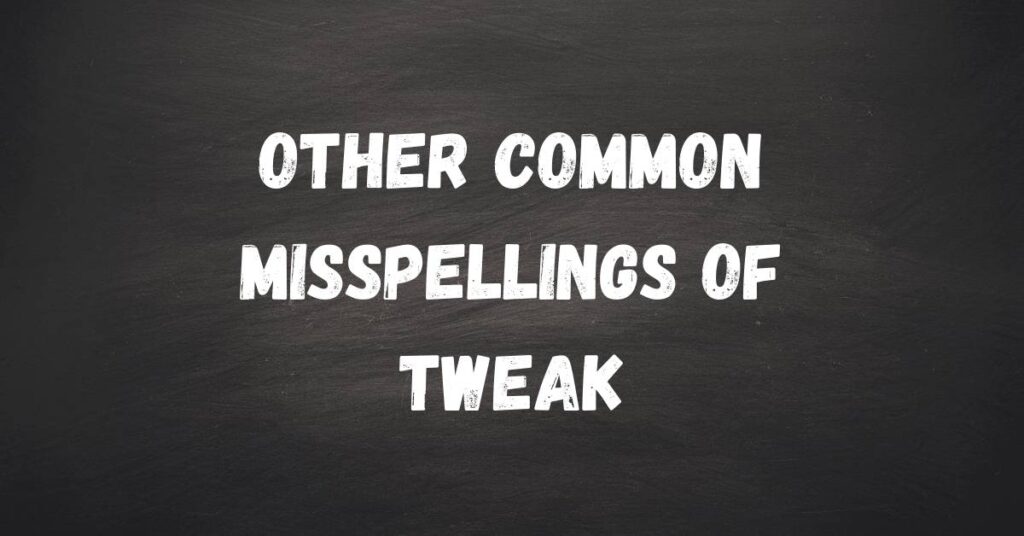Tweek vs Tweak is a common point of confusion for many writers and speakers. Understanding the difference between these two terms is essential for effective communication.
While tweak refers to making small adjustments or modifications in various contexts, such as writing, technology, or cooking, tweek is simply a misspelling that lacks any formal definition.
This article will explore the nuances of tweek or tweak, helping you navigate through the language confusion that often arises. By clarifying their meanings and usage, you’ll enhance your writing skills and avoid common spelling errors that could undermine your credibility in both casual and professional settings.
Quick Summary
Tweak is the correct word used to describe minor adjustments or modifications. On the other hand, tweek is often seen as a misspelling and does not hold any formal meaning in the English language. Recognizing this difference will not only improve your writing but also enhance your overall communication skills.
Difference Between Tweek vs Tweak

The primary difference between tweek and tweak lies in their usage. Tweak refers to making small adjustments or refinements in various contexts, such as writing, technology, or recipes. For example, you might say, “I need to tweak my report before submitting it.”
In contrast, tweek is simply a common error that people make when they intend to use the word tweak. Understanding this distinction can help you avoid spelling errors that could undermine your credibility.
Why Does the Confusion Between Tweek or Tweak Occur?
Several factors contribute to the confusion between these two terms.
Phonetic Confusion
One reason for this mix-up is the phonetic similarity of the words. They sound almost identical when spoken, leading many people to mistakenly write tweek instead of tweak. This can happen especially in casual conversations or informal writing where attention to detail may wane.
Autocorrect Errors
The role of technology in our writing processes. Autocorrect features on smartphones and computers often change words based on common usage patterns.
If someone types “tweak,” autocorrect might mistakenly suggest “tweek” if it recognizes that as a frequently typed word. Such autocorrect errors can lead to misunderstandings in written communication.
Origins of the Tweak
The word tweak dates back to around 1600, originally meaning “to pinch, pluck, or twist sharply,” often referring to the nose. This term likely comes from the Middle English “twikken,” which means “to draw or tug,” and traces back to the Old English “twiccian,” meaning “to pluck.”
Over time, its meaning evolved to include making fine adjustments, a usage that became established by 1966. Initially associated with mechanical adjustments, tweak now applies broadly to contexts like refining recipes or fine-tuning business proposals, showcasing its versatility in everyday language.
Tweek: Definition and Usage

Tweek is often seen as a misspelling of the word tweak. It does not have an official definition in standard dictionaries, and its usage is generally informal. People might use tweek in casual conversations or social media posts, but it can lead to confusion.
To communicate clearly, it’s important to use tweak, which refers to making small adjustments or modifications in various contexts.
Tweek Definition
Tweek does not have an official definition in standard dictionaries. Instead, it is mainly considered a spelling mistake and lacks recognition as a valid term in the English language, leading to potential confusion in communication.
Tweek: The Misspelling
Despite its lack of formal recognition, you may encounter tweek in casual conversations or social media posts. However, it’s crucial to remember that using this misspelling can lead to confusion and misinterpretation.
Why Is Tweek Considered Incorrect?
The reason why many consider tweek incorrect relates directly to grammatical rules surrounding spelling and word usage. In professional settings, using proper spelling enhances clarity and maintains credibility.
Cultural Use of Tweek
Particularly among younger audiences or in online slang, you may see people using tweek as a playful variation of tweak, but this should be approached with caution as it can confuse readers who expect standard English.
Tweak: Definition and Usage

Tweak refers to making small adjustments or modifications to improve something. It is commonly used in various contexts, such as refining a recipe, adjusting a piece of writing, or fine-tuning a machine.
For example, you might say, “I need to tweak my presentation for clarity.” Understanding how to use tweaks effectively can enhance communication and ensure that your message is clear and impactful in both personal and professional settings.
Tweak Definition
Tweak means to make small adjustments or improvements. It is frequently used across different fields, including writing, technology, and cooking, to describe the act of refining or enhancing something for better performance or clarity.
Tweak Usage
Using tweak correctly can greatly enhance your communication. For example: “I need to tweak my resume before applying for jobs.” This shows a clear understanding of how to apply minor adjustments effectively.
Usage of Tweak in Context
In everyday life, you might find yourself saying things like “I will tweak my workout routine” or “Let’s tweak this recipe for better flavor.” These examples illustrate how versatile the term can be across different contexts.
Tweak: The Correct Word
It’s important to use tweak when referring to making minor changes or adjustments. Using the correct term enhances clarity in communication and helps avoid confusion. Always remember that tweek is a misspelling and should not be used.
How to Pronounce “Tweak”
To pronounce tweak, say it as /twēk/. This phonetic pronunciation emphasizes the correct way to articulate the word. Knowing how to pronounce it properly will help you use it confidently in both spoken and written communication.
Synonyms of Tweak
Here are synonyms for tweak:
- Adjust
- Modify
- Refine
- Alter
- Change
- Fine-tune
- Improve
- Amend
- Enhance
- Correct
Side by Side Comparison
| Aspect | Tweek | Tweak |
| Meaning | No official meaning; a misspelling | To make small adjustments or modifications |
| Usage | Informal errors in casual contexts | Used in everyday and professional communication |
| Examples | “I need to tweek this document.” | “I need to tweak this document.” |
| Recognition | Not found in standard dictionaries | Standard English term; widely recognized |
Everyday Usage Examples

Understanding how to use tweak correctly is vital for clear communication. In everyday conversations, people often make adjustments to improve outcomes, whether in cooking, writing, or technology.
Recognizing the difference between tweak and its misspelling, tweek, helps avoid confusion and enhances overall clarity in language.
Tweek Example
Tweek is often mistakenly used in informal contexts. While it lacks a formal definition, it may appear in casual conversations or social media. However, relying on this misspelling can lead to misunderstandings and should be avoided for effective communication.
Examples of Tweek in Sentences
- I need to tweek my presentation before the meeting.
- Can you tweek the settings on your phone for me?
- She always forgets to tweek her recipes when cooking.
- They decided to tweek their approach for better results.
- Let’s tweek the design to make it more appealing.
Examples of Tweek in Context
- People might say they will tweek something without realizing it’s incorrect.
- Social media posts often misuse tweek, leading to confusion among readers.
- Some blogs may incorrectly use tweek instead of tweak, affecting their credibility.
- Text messages frequently show autocorrect changing tweak vs tweek.
- Informal writing can lead to misunderstandings when using tweek instead of the correct term.
Tweak Example
Tweak is commonly used to describe making small adjustments or improvements across various contexts. Whether refining a piece of writing, adjusting a recipe, or modifying a project, tweak emphasizes the importance of fine-tuning for better results.
Using this term correctly enhances clarity and effectiveness in communication.
Examples of Tweak in Sentences
- I need to tweak my essay to improve its clarity before submitting it.
- The designer decided to tweak the color scheme for a more modern look.
- After receiving feedback, she will tweak her presentation to address the concerns.
- We should tweak our marketing strategy to better reach our target audience.
- He plans to tweak the recipe by adding more spices for extra flavor.
Examples of Tweak in Context
- Chefs often tweak recipes to suit their personal tastes or dietary needs.
- Writers frequently tweak their drafts during the editing process to enhance readability.
- Software developers might tweak code to fix bugs and improve functionality.
- Teachers often tweak lesson plans based on student feedback and learning outcomes.
- Business professionals regularly tweak proposals to align with client expectations and requirements.
Examples of Tweak in Professional Writing
- The team will tweak the project report based on the latest data analysis.
- I need to tweak my resume to highlight my most relevant skills for this job.
- We will tweak our findings to ensure accuracy and clarity.
- The editor suggested tweaking several paragraphs for better flow and coherence.
- It’s essential to tweak your email communication style depending on your audience’s preferences.
Why Spelling Accuracy Matters

Spelling accuracy plays a crucial role in effective communication. When you use correct spelling like “tweak,” you convey professionalism and attention to detail. Errors like “tweek” can lead readers to question your credibility or understanding of the subject matter.
The Impact of Spelling Errors
Spelling errors can significantly impact how your message is received. For instance:
- In professional writing such as reports or emails,
- In academic settings where precision matters,
- In business proposals where clarity is key.
Each context requires careful attention to spelling because even minor mistakes can alter perceptions about your competence.
You May Also Like: Using or Useing: Which Spelling Is Correct?
Tips to Ensure Spelling Accuracy
To maintain high standards in your writing:
- Always proofread your work.
- Use spell check tools effectively.
- Familiarize yourself with common misspellings.
- Read aloud to catch errors.
- Keep a dictionary handy for reference.
These strategies will help you avoid common pitfalls associated with spelling errors like “tweek.”
Practical Tips for Refining Professional Writing
Improving your professional writing involves several strategies:
- Focus on clarity and conciseness.
- Use active voice where possible.
- Avoid jargon unless necessary.
- Tailor your language to your audience.
- Revise multiple times before finalizing documents.
By implementing these tips into your writing process, you’ll enhance both clarity and effectiveness in communication.
Read More Article: Motif vs Theme: What’s the Difference?
Other Common Misspellings of “Tweak”

Some other frequent misspellings include:
- Teak
- Twick
- Tweck
- Twik
- Teek
Being aware of these variations can help you spot errors more easily when proofreading your work.
Example Sentences of the Misspelling of “Tweak” as “Tweek”
You might encounter sentences like:
“I need to tweek my presentation tomorrow.”
This example shows how easily someone might slip into using “tweek” without realizing it’s incorrect.
Other examples include:
“Can you help me tweek this document?”
Each instance highlights how common this misspelling can be if one isn’t careful about their writing choices.
The Importance of Small Changes in Professional Writing
Small changes can lead to significant improvements in professional writing quality. Whether you’re adjusting tone or refining vocabulary choices, these tweaks ensure that your message resonates with your audience effectively.
Editing and Revising
Editing plays an essential role in enhancing clarity and precision within written work. By taking time to revise drafts thoroughly focusing on aspects such as syntax parsing and grammatical analysis you’ll produce clearer documents that convey ideas more effectively.
FAQs: Tweek and Tweak
Is “tweek” ever an acceptable spelling?
No, “tweek” is considered a misspelling of “tweak” and is not recognized as a valid word in standard English dictionaries.
Is Tweek a real word?
No, “tweek” is not a real word; it is simply a common misspelling of “tweak,” which has an established meaning.
What is the idiom of tweak?
The term “tweak” does not have a specific idiom but generally refers to making minor adjustments or improvements.
What does “tweak” mean in Gen Z?
In Gen Z slang, “tweak” can mean to act erratically or to be overly excited, often in response to something surprising or amusing.
What does Tweek mean in slang?
In slang, “tweek” may refer to someone who is acting strangely or erratically, but it is primarily viewed as a misspelling of “tweak.”
Conclusion
Understanding Tweek vs Tweak is crucial for clear and effective communication. While tweak signifies making small adjustments that enhance clarity and precision, tweek remains an incorrect spelling that can lead to misunderstandings.
By recognizing the importance of proper spelling and usage, you can avoid common spelling errors that detract from your credibility. Whether in professional writing or everyday conversations, mastering the distinction between these terms will improve your overall communication skills and ensure your message resonates with your audience.

